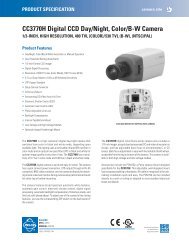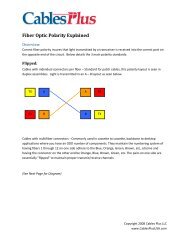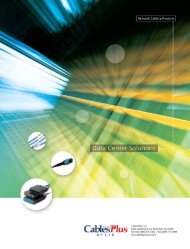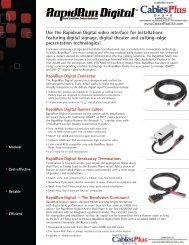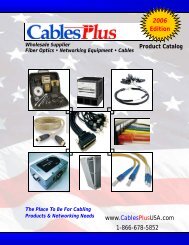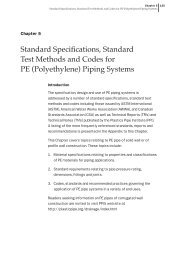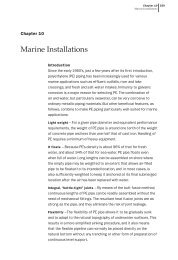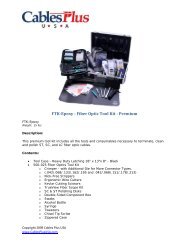Learning About Options in Fiber - Cables Plus USA
Learning About Options in Fiber - Cables Plus USA
Learning About Options in Fiber - Cables Plus USA
You also want an ePaper? Increase the reach of your titles
YUMPU automatically turns print PDFs into web optimized ePapers that Google loves.
SECTION 2—FIBER-OPTIC BASICS<br />
In loose-buffer tube designs, the fiber tube is usually<br />
filled with a viscous gel compound which repels<br />
water. Slotted, or envelope designs are usually filled<br />
with a water-repellent powder. Although water does<br />
not affect the transmission properties of optical fiber,<br />
the formation of ice with<strong>in</strong> the cable will cause<br />
severe microbend<strong>in</strong>g and added dB loss to the<br />
system.<br />
A comparison of loose tube features to tight tube is<br />
provided <strong>in</strong> section 3, Table C.<br />
Strength Member<br />
Strength members add mechanical strength to the<br />
fiber. Dur<strong>in</strong>g and after <strong>in</strong>stallation, the strength<br />
members handle the tensile stresses applied to<br />
the cable so that the fiber is not damaged.<br />
The most common strength members are of Kevlar<br />
aramid yarn, steel, and fiberglass epoxy rods.<br />
Kevlar is most commonly used when <strong>in</strong>dividual<br />
fibers are placed with<strong>in</strong> their own jackets. Steel<br />
and fiberglass members are frequently used <strong>in</strong><br />
multifiber cables.<br />
Jacket<br />
The jacket, like wire <strong>in</strong>sulation, provides protection<br />
from the effects of abrasion, oil, ozone, acids,<br />
alkali, solvents, and so forth. The choice of the<br />
jacket material depends on the degree of resistance<br />
required for different <strong>in</strong>fluences and on cost.<br />
A comparison of the relative properties of various<br />
popular jacket materials is provided <strong>in</strong> section 3,<br />
Table D.<br />
ADDITIONAL CABLE CHARACTERISTICS<br />
<strong>Cables</strong> come reeled <strong>in</strong> various lengths, typically<br />
1 or 2 km, although lengths of 5 or 6 km are available<br />
for s<strong>in</strong>gle-mode fibers. Long lengths are<br />
desirable for long-distance applications s<strong>in</strong>ce<br />
cables must be spliced end-to-end over the length<br />
of the run, hence the longer the cable, the fewer<br />
the splices that will be required.<br />
<strong>Fiber</strong> coat<strong>in</strong>gs or buffer tubes or both are often<br />
coded to make identification of each fiber easier.<br />
In the long-distance l<strong>in</strong>k it’s necessary to be able<br />
to ensure that fiber A <strong>in</strong> the first cable is spliced to<br />
fiber A <strong>in</strong> the second cable, and fiber B to fiber B,<br />
and so on.<br />
In addition to know<strong>in</strong>g the maximum tensile loads<br />
that can be applied to a cable, it's necessary to<br />
know the <strong>in</strong>stallation load. This is the short-term<br />
load that the fiber can withstand dur<strong>in</strong>g the actual<br />
process of <strong>in</strong>stallation. This figure <strong>in</strong>cludes the<br />
additional load that is exerted by pull<strong>in</strong>g the fiber<br />
through ducts or conduits, around corners, etc.<br />
The maximum specified <strong>in</strong>stallation load will establish<br />
the limits on the length of the cable that can<br />
be <strong>in</strong>stalled at one time, given the particular application.<br />
The second load specified is the operat<strong>in</strong>g load.<br />
Dur<strong>in</strong>g its <strong>in</strong>stalled life, the cable cannot withstand<br />
loads as heavy as it withstood dur<strong>in</strong>g <strong>in</strong>stallation.<br />
The specified operat<strong>in</strong>g load is therefore less than<br />
the <strong>in</strong>stallation load. The operat<strong>in</strong>g load is also<br />
called the static load. For the purposes of this discussion<br />
we have divided the discussion on cables<br />
by <strong>in</strong>door or outdoor.<br />
Figure 2-13—Indoor <strong>Cables</strong><br />
Buffered Optical<br />
<strong>Fiber</strong><br />
Kevlar<br />
Strength<br />
Member<br />
Buffered<br />
Optical <strong>Fiber</strong><br />
Kevlar<br />
Strength<br />
Member<br />
Buffered<br />
Optical <strong>Fiber</strong><br />
3.0<br />
[.118]<br />
3.0<br />
[.118]<br />
3.1<br />
[.122]<br />
Kevlar<br />
Strength<br />
Member<br />
Outer<br />
Jacket<br />
0.9<br />
[.035]<br />
Outer<br />
Jacket<br />
6.1<br />
[.240]<br />
0.9<br />
[.035]<br />
<br />
Outer<br />
Jacket<br />
5.6<br />
[.220]<br />
0.9<br />
[.035]<br />
Simplex<br />
Duplex<br />
Duplex<br />
2-9



